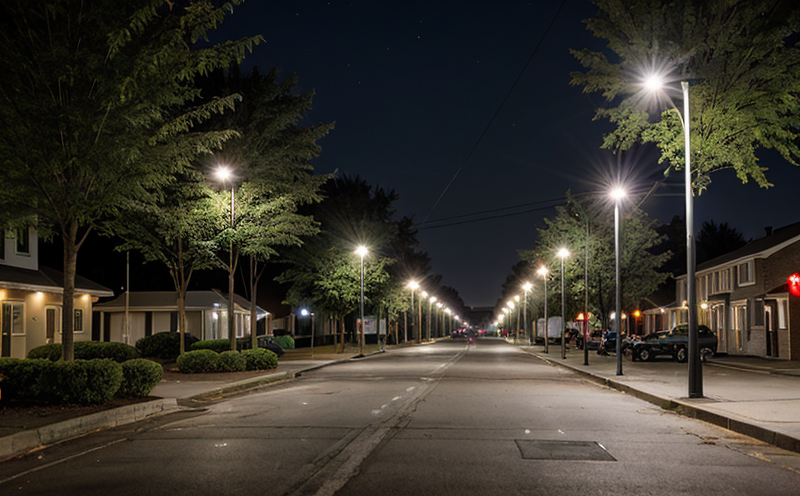EN 12464 2 Outdoor Lighting Performance Testing of Public Spaces
The EN 12464-2 standard is a pivotal document for ensuring the quality and performance of outdoor lighting installations in public spaces. This standard specifically addresses the testing requirements to verify that lighting installations meet all design criteria necessary for safe, efficient, and aesthetic operation.
The standard applies to permanent street and other public space lighting systems designed for use outside buildings. It covers various aspects such as light distribution, luminance levels, uniformity of illumination, and glare control measures. The primary focus is on the performance characteristics that are critical for ensuring public safety, environmental harmony, and energy efficiency.
The testing outlined in EN 12464-2 aims to ensure compliance with international standards while providing a framework to evaluate how effectively lighting systems function under real-world conditions. This involves rigorous tests designed to simulate actual usage scenarios, thereby guaranteeing that the installed systems perform reliably over time.
Testing according to this standard ensures that all components of an outdoor lighting system are correctly specified and installed. It also helps in identifying any potential issues early on so they can be addressed before full-scale deployment. By doing so, it supports the overall goal of providing well-designed public spaces that contribute positively to urban environments.
For effective implementation of EN 12464-2 standards, several key parameters need careful attention during testing:
- Light intensity and distribution patterns
- Luminance levels within defined zones
- Uniformity ratio between different areas
- Glare control measures
The process typically starts with a thorough inspection of the lighting installation, followed by precise measurements using specialized equipment. These tools allow for accurate assessment based on predefined criteria outlined in the standard.
One important aspect is ensuring that light levels are adequate but not excessive, balancing functional needs against environmental considerations. Another critical factor is minimizing unwanted reflections and shadows to enhance visibility without causing discomfort or distraction.
In summary, compliance with EN 12464-2 is essential for maintaining high standards in outdoor lighting installations across various public spaces like parks, streets, highways, and pedestrian areas. By adhering strictly to this standard, organizations can ensure that their lighting systems not only meet regulatory requirements but also contribute positively towards sustainable development goals.
Scope and Methodology
| Test Parameters | Description | Methodologies |
|---|---|---|
| Light intensity and distribution patterns | Measuring the amount of light emitted in different directions from each luminaire. | Using photometers at multiple points around the installation to capture data. |
| Luminance levels within defined zones | Determining how bright specific regions appear relative to surrounding areas. | Employing luminance meters placed strategically according to specified distances and angles. |
| Uniformity ratio between different areas | Evaluating the consistency of light distribution across various sectors. | Comparing measured values from similar locations using standardized scales. |
| Glare control measures | Analyzing whether excessive brightness causes discomfort or impairs vision. | Conducting visual assessments and utilizing glare meters to quantify light levels. |
The methodology described above ensures comprehensive evaluation of each parameter, providing robust evidence supporting compliance with EN 12464-2. This approach guarantees accurate assessment results which are crucial for making informed decisions regarding lighting design improvements and maintenance schedules.
Quality and Reliability Assurance
The success of any outdoor lighting project hinges significantly on the quality assurance measures implemented throughout its lifecycle. Ensuring that every component meets the stringent requirements set forth by EN 12464-2 is paramount to achieving long-term reliability.
A robust quality management system plays a vital role in maintaining consistent performance standards. Regular inspections and periodic retesting help identify any deviations from expected norms, allowing timely corrective actions to be taken. Additionally, adherence to best practices during installation and maintenance further reinforces the integrity of the lighting system.
By incorporating advanced monitoring technologies into ongoing operations, continuous assessment becomes possible even after initial deployment. This proactive approach enables early detection of potential issues before they escalate into significant problems requiring extensive repairs or replacements.
In conclusion, implementing comprehensive quality assurance protocols based on EN 12464-2 not only enhances the longevity and effectiveness of outdoor lighting installations but also fosters trust among stakeholders by demonstrating commitment to excellence in every aspect of design and execution.
Use Cases and Application Examples
- Park Lighting: Ensuring adequate light levels for safe walking paths, playgrounds, and seating areas while maintaining low glare for visitors' comfort.
- Highway Interchanges: Providing sufficient illumination around ramps to improve driver visibility during night-time conditions.
- Bridges: Installing lighting that enhances structural aesthetics without compromising safety or causing excessive light pollution in nearby residential neighborhoods.
- Pedestrian Walkways: Designing installations that direct foot traffic effectively while minimizing shadows and glare.
The versatility of EN 12464-2 allows for tailoring lighting solutions to meet specific local needs. Whether it's enhancing security in urban centers or promoting eco-friendly practices through energy-efficient designs, this standard provides the flexibility needed to address diverse applications successfully.





